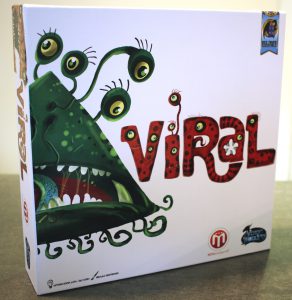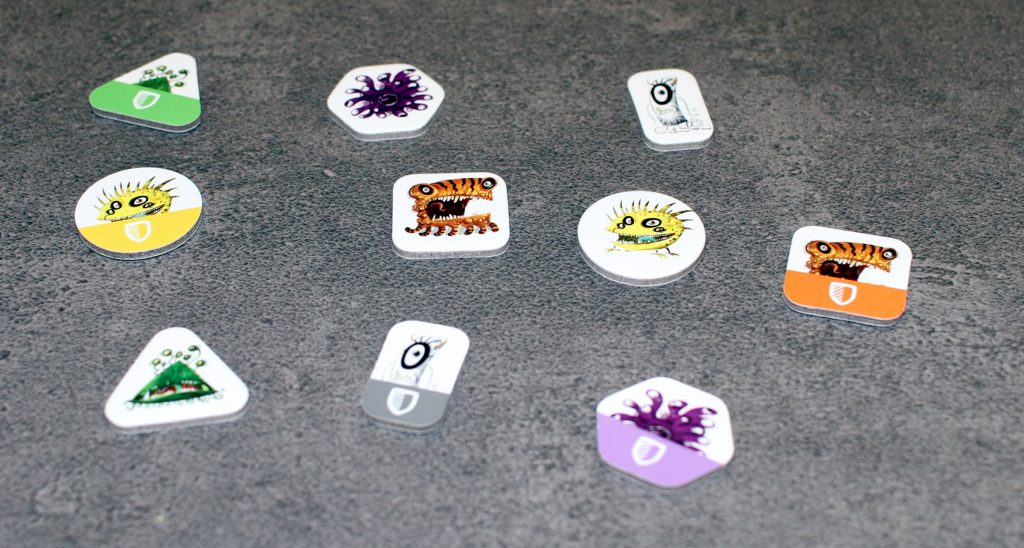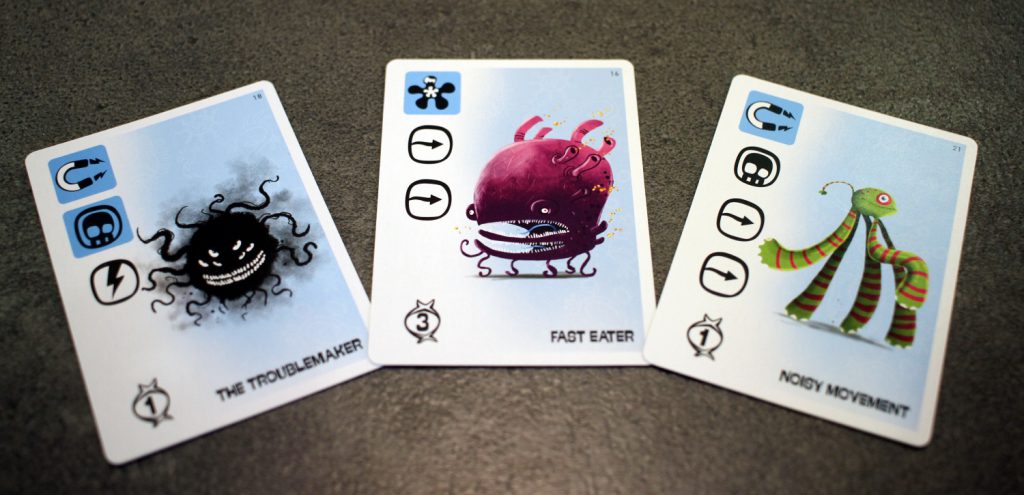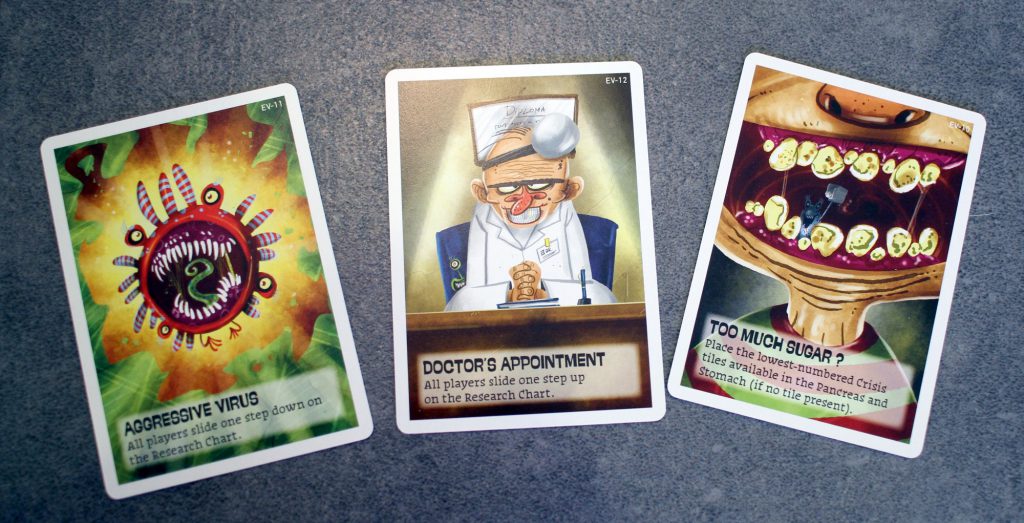VIRAL (2017)

Welcome to ‘The Lab’, my dear… Well, it’s not so much a lab as it is a sweaty duvet however, I can assure you it is, in fact, full of the viruses which make up the focus of this piece. No, please don’t run – I assure you we’ll have a jolly good time. And I have closed the airlock.
Ridiculous preamble out of the way, allow me to introduce you to the recent discharge of Arcane Wonders, incubated in the fine minds of Gil d’Orey & Antonio Sousa Lara, VIRAL.
VIRAL is a visual feast of an area control game which purports to run to completion over 60 to 90 minutes. Of low-to-intermediate complexity, yet significantly greater depth, this title couples an interesting nodal routing problem with an engaging card-play mechanism which demands decent forward planning on the part of the players.

In VIRAL, the players are competing viruses who are working to most prolifically infect the ‘patient’ who makes up the board over the course of six rounds. You will be navigating the circulatory system and interfering with your opponents viruses, all whilst remaining under the radar of the host’s immune system.
Sounds dark, doesn’t it? Don’t worry as it’s anything but…

The first thing that’s apparent is that Mihajlo Dimitrievski has been given a decent amount of creative freedom when composing the art for this game. The drawings that make up the centrepieces of the cards are always fabulous, oft-amusing and occasionally hilarious. The closest visual analogue I can think of is Ricky Gervais’ children’s storybook project, Flanimals, where one is left wondering to the state of the artist’s mind. Assuming said creatures had spawned bastard progeny with the drawings from the Hungry, Hungry Caterpillar, this warped yet fabulous offspring would be the outcome.

We’re kept off-piste with a board that refuses to conform to normal board game conventions, using almost every conceivable color somewhere upon it, yet it works. The representation of a human circulatory system and organs is striking, the line work and flashes of colour lending a suitably cartoon-like vibe, yet also serving as functional prompts to elements of the game’s rules, specifically the direction of routing (more on that later). Finally, the templating, be it on the cards or the round structure guide on the side of the board, is quirky yet entirely consistent and functional.

If only Arcane Wonders & Mesa Games, the publishers of this game, had coupled the artist’s investment in time to a similar devotion to quality materials. The cardstock utilised for the tokens and player boards are beyond reproach, however, the centerpiece of the game suffers a couple of significant issues. Our review copy had a number of print issues on the main board, specifically, print lifting and smudging. Further to the print issues, the main board was quite poorly taped, unsightly seams being apparent in the middle of two of the panels.
It should be noted that other recipients have made similar complaints which suggest a batch issue rather than a one-off production failure.

Of greater concern than batch production issues, is the material choice made for the playing cards, a game component that for this title makes up a core part of the play experience. As they are being used to drive the action, you’ll spend a lot of time handling them, staring at their faces pensively, soaking in the artwork and iconography whilst considering your next move. Sadly they are of distinctly average cardstock, not being canvased or even particularly robust feeling, which is a shame as the artwork on the cards deserves more. The publishers have made the eminently sensible decision of having white borders on the cards, meaning they should wear well, chipping being less apparent than on cards featuring edge-to-edge art. However, the pure white rear of the cards is likely to attract marks, like bacteria to a nutrient broth, which for a competitive action selection come programming game, matters. I’d absolutely budget for sleeves to protect your investment.
This visually focused attitude further extends itself to the manual. Although I believe it’s arguably a bit longer than necessary, almost every rule element is lovingly outlined with graphical aids to complement the prose. In fact, it’s plausible to teach someone how to play this in circa ten minutes. Don’t be put off by the 15 pages of instructions, please!
That said, I appreciate the publisher’s efforts in making sure all cases, core and fringe, are explicitly covered, so you aren’t forced to make any house rulings. In many genres, the game atmosphere will survive midgame improvisations resultant from a contracted rulebook, but the zero-sum nature of area-control games means they are not so forgiving, what with there being an outright winner and loser in any given rule decision.
But art without function is not a board game, so let’s talk to what you do with this smörgåsbord of lavish components. During a game of VIRAL, you’ll be taking actions to deploy, move, shield, attack and trap viruses over twelve turns. Every other turn, local and special scoring criteria will be evaluated, assessing majorities across the board to pay out ‘Virus Points’ (glorious) and ‘Research Points’ (wretched). Virus Points make prizes, enabling you to pick up new cards into your player deck once you pass certain thresholds, increasing your in-game options and directly granting you end-game VP. Research Points make for eradication, wiping your presence from the board like as much surgical spirit from a hastily sterilised operating table.
Ah, but we must zoom in our microscopes, fair lab assistants! For the method by which you take turns is a significant part of the magic. On a given turn, all players select two cards simultaneously, one determining the organ to which your action card will target, the other being the action(s) you wish to take. In clockwise order, the players will utilise their selected actions to maximize their presence on the board in the places they wish to control. It’s the flexible programming you might be familiar with if you’ve played Spiele Das Jahres winner Colt Express, rather than the brittle (yet oh so satisfying) programming of Lords of Xidit. Or C++.
You’ll go through this process one more time each round, using a different pairing of cards, before discarding all four cards to a quarantine area. You will not be able to select those organs or actions for another round, the cards only being squirted back into your hand after they’ve been displaced by the next round’s cards. Oh, but you will so want those cards that have been locked away from you! How will I get to the brain now, you wonder. Surely there’s a way I can smack Daniel out of the lungs with my ‘Attack’ card in absentia?
A few games come to mind that make use of this sort of restriction, but the most popular one I can think of comes from the heavier end of the spectrum, specifically Alexandar Pfister’s 2015 hit, Mombassa. That heavy Euro saw you in a much drier setting, specifically the African continent, developing companies and setting up trading stations over the course of roughly three hours. In both titles, the rules of play limiting how often and in what combination you can play cards, increase the depth of the gameplay by factors. Everyone wants to do key actions over and over again, but the game dictates this is an impossibility, so victory will likely go to the person who can play the situationally key combination of cards at the right time and make the best out of what remains of their hand. It’s a very tidy, fair mechanism which provides the players with a high quality of decision which they have to make. It’s a pleasure to see it feature in a lighter title, yet shockingly, it’s only my third favourite aspect of this game!

Another masterstroke is how majorities are calculated. Each zone is typically made up of two (or more) organs and you have to be present in all organs to qualify for scoring a zone. Whoever is the most populous in an organ wins all the Virus Points and, sadly, the Research Points. This leads to wonderful situations whereby a clever play can take you from being the weakest actor in an organ to the *only* viable actor in an organ, through trapping or eliminating other player’s presence in one-half of it.
Nowhere is safe, but accordingly nowhere is unassailable. From a game design point of view, it’s a fine balance to reach, sublime equilibrium a rare treat indeed. A bit like pornography, hard as it might be to define you know when you’ve experienced it, but try to define it succinctly, I shall. Quality area control leaves you feeling under threat, yet never out of the running and never, ever cheated. VIRAL ticks those boxes with aplomb.
Never one to leave a tired metaphor unused, I’ve saved the best until last. Remember that I described the map upon which you deploy your genetic payload as an abstraction of the human circulatory system? Well, that concept is carried through beyond mere graphics. You can only travel between organs whilst honouring the biological one-way system, travel contraflow to the hearts pumping action being impossible. The conceit is fully committed to, some organs being more easily accessed than others. Travel between the lower regions is easy, the kidneys, digestive organs and pancreatic region being hyperconnected. Whereby the heart grants you fantastic access to the rest of the body, the blood-brain barrier encompassing the delicious skull meat acts as a virtual prison. Oh, but what a sweet, sweet prison! The brain is made up of only one region, making it easier to control and score meaning success is plausible here for minimum investment, assuming your competitors cooperate. However, it’s pretty much isolated, access and egress via the move action being somewhat challenging. Viruses deployed here aren’t going to be launching any surprise attacks in a hurry.
Of course, I make it sound easy, but the reality is that you likely won’t comprehend the consequences of this unique map layout for about three turns, by which time your viral material could be largely deployed, committed to the wrong places for the next scoring window and vulnerable to attack by anyone with half an ounce of grey matter. Oh, if only I’d paid more attention during biology at school! Then I’d be doing better at this game and I’d still have both of my… anyway.
What I’m crudely trying to articulate is this: The map upon which you fight is possibly the most interesting element of the whole package. Intelligent without being obtuse and challenging without being masochistic. It’s the most intriguing fixed board I’ve seen in an area control game for a long time. Tammany Hall runs it close with the defined order of score calculations yet it does not carry its motif through every phase of play in the manner of VIRAL.

These high points are coupled with some effort towards increasing replayability. The designers have afforded a small degree variable setup, each organ being worth a different amount of VP and RP for each instance of the game. There are also thirteen special scoring condition cards which could come out in any order across the six-game rounds. They may reward presence in given organs, modify the rate of Research Point accrual or make certain areas easier (or harder) to contest, changing the general tactical focus of the game. Is the heart a directly rewarding place in this game, or is its strategic value to springboard across the map my primary consideration? Is the brain worth one virus? Two? Surely not three?
(Editor: Never three – it’s too removed from the rest of the board)
Further to this, the light deck building element adds some in-game variation, seeing the players add up to four action cards to their deck from a rolling, three card market (or taking a blind draw from the top, resetting the trade row) once they cross certain scoring thresholds. These cards are occasionally wild in their artwork and game effects but often are functional upgrades to your starting deck of action cards. The impact/quality of the 22 cards is weighted against their value in end-game Virus Points, the more effective (and I would argue ‘fun’) cards being worth fewer VP, which at times creates a nice valuation challenge for the players during the scoring windows. Early game, I want effective cards, but is that 2VP card really that much worse than the 0VP card? However, this decision is less challenging in the latter turns of the game, as all you will care about is the VP value on the card. If there are no 3VP cards for you to scoop up you’re going to feel seriously peeved, unless you’re nicer than me. Actually, you’re probably nicer than me… statistically speaking.
All that being said, as much as I enjoyed my plays of this title, I am left with a questionable smear in my Petri dish, an outlier in my results, a null in my hypothesis (yeah – that sounds right)…
I’m not sure how long the legs on this game are really likely to be. I’m left wondering if this will remain evergreen and vibrant like as much gangrenous puss or will it perish and wither like a tropical disease infected limb?
I’m not sure the variety here is quite enough to keep me hungry. For context, I’m a fan of variable setups* as a means of increasing replayability for a title, as they can reward a player developing experience. On a given board layout, the more practiced players should be more able to read the configuration to identify high-value strategies, which for most games I’m looking to dump 90 minutes or more into on a regular basis, is positively a boon. I want to feel like a game has hidden depths available for one to explore and I actually want to notice myself getting better at it!
However, that variation really has to mean something. If the differences are insignificant – if you wouldn’t tangibly modify your strategy and approach in response to the flop, it’s unlikely to pull me back in time and time again.
For me, VIRAL fails that test.
Once you’ve decrypted the flows of the map, it seems to me that certain plays are always likely to be stronger than others. The heart is always going the be good in terms of routing and the brain a potential trap. It is just a question of which other organs you’re going to squirt along to and in which ratios rather than a complete reinvention of your approach each time.
The enhanced action cards available in the marketplace which vary game-to-game are fun, don’t get me wrong, but they aren’t fundamentally that different to what you start with. Although the magnet and absorb actions are exciting the first time you use them, it’s not long before you’ve worked out the nuances. Furthermore, as with anything dependent on a trade row, it’s a bit of a crapshoot as to what’s available when your turn to select comes around. Have the other players diminished the value of the market so there’s a little choice left or perhaps no choice at all? Are you going to have to be the mug who refreshes the trade row via a blind draw, exposing new value for everyone else? I don’t know, but it’s a dull mechanism in this otherwise elegant box of toys.
In fairness, if trade rows aren’t your speed, then the manual does include an opening draft variant where the players build their sequence of upgrade cards from a shared pool, said personal decks to remain in a fixed order and their composition open information to your opponents. With a table of experienced players, I could see this extra ten minutes investment up front reduce the amount of luck involved in the game’s outcome significantly, although of course not entirely. Nor would it really work when the game involves newer players, as drafting something you have no practical understanding of the value of is all but an impossibility.
Ultimately though, it has to be said, the novelty of discovering new cards will eventually run out.
Trying to remain somewhat objective in my assessment of this exciting title, I have to record in my lab book that the play time on the box seems rather optimistic. Our first play of this with four players, including teaching, was over two and a half hours. With experienced players, this comes down a lot. Heck, if you have someone directing the play and keeping the cadence up, you can get the game completed in the advertised time, just. Frankly, your lab coordinator will be sucking the fun out of proceedings with their proverbial ‘joy syringe’, as this title lends itself to deep rumination on each of the active phases, specifically card selection and action deployment. If you’re taking it seriously, trying to predict what others will do during the simultaneous action selection phase, completing this game in 90 minutes for four players upwards is highly unlikely, unless all the players don’t care about the outcome. You’re always going to be waiting on the slowest player to pick their cards, and there is always one. Lindsay…
Of course, you can rip through the end of round administration quickly enough, but that won’t help you catch the last bus from campus.
On player counts, I recommend playing this game with three or four players, as it struggles at two and five for different reasons.
At two players, the game relies on an unimaginative robot player to balance things. I found the amount of overhead the automaton required a bit much for my tastes, as you have to actively score the thing yet it does not provide an element you can actively finagle to your opponents detriment. I’m not adverse to robot players, Dirk in Alhambra being a classic, but it didn’t sing for me here. This adapted design doesn’t really work which should provide no surprise, as the top of category area two player area control games are designed as such from the ground up. A notable exception, should you be looking for such a versatile beast is Tony Boydell’s ‘Guilds of London’, published by Tasty Minstrel Games.
What about the opposite extreme, when the agar jelly is overflowing with participants? Five doesn’t qualify as overflowing I here you say? I guess your pedantry is the sign of an analytical mindset, but back to point…
At five, there isn’t quite enough ‘space’ for everyone to necessarily score. To quote one of my playtesting colleagues, this game made him “feel bad”. The bacterial overlord concerned scored a fraction of the leader’s points hence only managed to pick up one of their four upgraded cards, meaning they were completely unable to ‘fight back’ throughout the duration of the game. In the interests of transparency, I should state that it was his first play of the game against two very experienced players, so perhaps this was more a product of the game’s catch up mechanisms (losing player winning area control ties) being inadequate to bridge significant skill gaps. The author does however question, should skill gaps be narrowed through game mechanics in every title? Does providing the proverbial ‘Blue Shell‘ not reduce the agency of the players at the table? Your tastes, of course, will vary, but I don’t conclude that a game that fails to totally flatten the playing field between novice and the experienced player is flawed. The opportunity to thrive or fail, live or die, ‘infect or stagnate’, as a result of one’s own actions with no safety net present can be a treat indeed. For does anyone argue Chess requires a catch-up mechanism to prevent snow-balling? Indeed, for a visceral by nature area control game to include catch-up mechanisms, the designer must be very careful not to create a negative ‘leader experience’ by having them too overbearing. When good table play is punished by the brutal application of ‘sweets for everyone else’, a game’s character and objectives become very different, the optimal position being second place. Candidly, if I wanted to play Tammany Hall, I’d put it on the table, so I’m glad Gil d’Orey & Antonio Sousa Lara didn’t go too far with their balancing.
Hypothesising aside, I believe the negative experience for the newer player was more likely due to the board just being generally so very tight at the top player count, making non-scoring rounds all but guaranteed when you ‘get it wrong’, making the cost of learning quite high. I also noted that at five players, there was just a little bit too much going on, making working out how your opponents were likely to apply their actions incredibly difficult, something both the ‘control minded’ amongst you and new players may not appreciate. I mean, what self-respecting scientist appreciates confounding variables and lack of control(s)?
Don’t misunderstand me! Pretending to be a virus in the world of VIRAL is an enjoyable activity and it’s a game I will doubtless pull out a few times a year, as it does area control very well indeed, with the right player count. However, it’s not something I’d look to play every week, every month, or even necessarily every quarter. The production values are fabulous, the term ‘feast for the eyes’ not being mere hyperbole. The mechanisms deployed are, for want of a better word, tidy , providing a high quality of decision into a very tight ruleset. However, much like that pet chinchilla that seemed so neat in the village garden center, its repertoire is actually quite limited. There’s only so many different positive things to try.
In closing, I’d give it a distinctly unscientific 7/10. I’d play it anytime someone else asked, would recommend it if someone wanted to play an area control game of middling complexity but won’t be carrying it down to games night with me each and every week as a staple. My initial cynical read was that the wonderful art may be obscuring a weak game with mechanisms lacking in depth. I’m pleased to report my hypothesis was definitely wrong, but nor is it the last word on area control.
* I’m a bigger fan still of board states which are modified by the player’s decisions, as this creates a level of interaction which is akin to a drug for me, in the emotions it prompts. Glorious highs and vicious lows are aplenty when you and your cohorts create and deny opportunities for each other through the framework of the game’s mechanisms itself. Well designed games have less dependency on variable setups to enhance replayability as every instance of the game will be as unique as the combination of personalities at the table.


